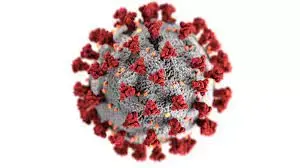They tested people to check for evidence of asymptomatic infection and found that people who had two doses of the nasal vaccine showed no signs of infection after three months.
CONCLUSION. A 2-dose intranasal vaccination regimen using NB2155 was safe, was well tolerated, and could dramatically induce broad-spectrum spike-specific sIgA in the nasal passage. Preliminary data suggested that the intranasal vaccination may establish an effective mucosal immune barrier against infection and warranted further clinical studies.
https://insight.jci.org/articles/view/180784
"At least 86.2% participants who completed 2 [nasal vaccine] doses maintained uninfected status, likely without even asymptomatic infection, for at least 3 months.
https://xcancel.com/EricTopol/status/1838937705977110991#m
Seems like we are getting closer to better vaccines being approved.
Xi please give this to me I've been in quarantine for 5 years
 ->
-> 
The Russian Sputnik vaccine has had an intranasal form for years, I'm not sure if efficacy is different.
So is this a "I don't have to be the weirdo with the mask" thing?
Not if you want to be logically consistent with the same logic used by people still masking today
At least 86.2% participants who completed 2 [nasal vaccine] doses maintained uninfected status
That means up to 13.8% still got infected at some point
So no if you want to minimize your risk of infection as much as possible then no it's not "throw away your mask and cheer" time
This is still good news though
It sounds much more positive than that. The people who where infected after 2 doses were infected within 3 days of the taking dose while everyone who avoided infection for that 3 day incubation was uninfected for 90 days after that even as protections were dropped and 80% of the population were infected during the same time period. This is ofc only a 31 person sample size and only based on reported symptomatic infections within 90 days so can't get too excited yet.
If it's cheap enough maybe I can force the people I'm with to use it at least. Maybe...
I'm hopeful, but there are a couple things that have me questioning this
First of all, they say outright
The primary objective of this study was to evaluate the safety and immunogenicity of intranasal vaccination, which was not designed to assess protection efficacy.
So they're not actually testing protection from covid really? And as such they say
The limitation of this study in assessing protection effectiveness was the lack of a placebo group to monitor the infection rate with the exact timing as the intranasally vaccinated group
So although the protection rate has me hopeful, it seems they can't actually say that this has any more protection over no mucosal vaccine
The zero-COVID policy was lifted when this study began. Many participants were infected before the vaccination could induce sufficient immune barrier to counter infection, and these infected participants had to drop out of the study.
Nearly 75% of participants infected after first dose
Remarkably, among 31 participants who received the second dose (December 28–30, 2022), only 2 participants reported infection on day 1 and day 3 after vaccination. After that, all 29 participants reported no infection for the following 3 months.
So a lot of participants in the study actually got infected and didn't finish the study. Is it possible that those who finished the study were just more cautious about covid in other aspects of their life? Like I can go 3 months with no infection just wearing a mask, and it doesn't seem like this study tracked non-vaccine covid precautions in participants, nor is there a placebo to which to compare the group that finished the study. Although this study has me hopeful, this doesn't seem like the deus ex machina that I want it to be. Maybe someone can let me know if I'm reading it wrong though. It's also 5am and I'm falling asleep so maybe I missed something
Edit: they also explicitly say
People who got an infection were excluded from the study.
So they're not actually testing protection from covid really?
Not yet. Stage 1 clinical trials are not meant to assess efficacy, that's what the next stage will cover. For more info, this page gives a good overview on clinical stages under the "Testing the Vaccines in People" heading. My familiarity is from the US, so it's possible stages are different in China.
I'm not going through the entire study now because it's late and I'm sick, but they would need to exclude those who were infected before the date they are deemed "fully vaccinated" as this would affect their immune response and obfuscate their results, particularly in terms of protection. They would want to see protection only after full vaccination in this study design
Main takeaways from this paper:
-
Intranasal vaccination was well-tolerated (it doesn't suck to get, meaning it could move to the next trial stage),
-
More studies are needed to be sure, but there were indications that an Intranasal vaccine could be effective in preventing infection.
This will be a lot of simplification and glossing over details, but the main immunological difference in intramuscular (IM) vs Intranasal (IN) vaccination is the type of protections they confer...
The goal with IM is typically to help reduce the length and intensity of an infection, to induce a biological memory to help you fight off an infection, not to completely prevent it from happening. IM vaccination activated IgG, so you'll see them look for IgG levels and T-cell responses. The type of IgG activation helps tell you what type of T helper cell profile skewing is created, and different profiles can correlate with protection for specific diseases.
Aside from not having to get a shot, IN vaccines aim to create an IgA response rather than just IgG. IgA is able to actively prevent infections from ever occurring by offering protection within your mucous membranes. This is in addition to the type of protections you get from IM administration. The drawbacks to IN vaccination are mainly that it's harder to induce the same levels of protection as with IM. You have to deliver the vaccine to cells in the mucous membrane, which is harder, because mucous acts as a barrier to delivery of your active vaccine components and clears on the order of minutes. This means dosing is different and this plus the difference in immune cells and trafficking of active components can lead to lower immune responses.
IN administration has been used for a relatively short time (in vaccine history), but it's shown some success (influenza and allergies in particular come to mind) and is a focus for many ongoing programs because of the potential for mucosal immunity. Creating effective mucosal immunity will not only protect the vaccinated individual, but prevent spread, which is something the IM vaccines can't do.
-
All true caveats, but they do clarify it's just preliminary data suggesting that it works positively. Literally nobody who had time to respond to the second dose got infected.
Obviously an actual study of effectiveness is important and will have the real answers. But it comes in stages, and stage 1 is establishing that it's safe to use and theoretically works, which they successfully did here per their aims. Mentions of effectiveness are just "at a glance it looks good" and that there's currently no good reason to doubt the vaccine works as intended.
Good points. Without reading deeply, my main question is how long this protection lasts? The mRNA vaccines only confer ~4 months of protection, but this seems to be an inactivated virus with full spike protein.
If this could 1) prevent infections, and 2) confer protection for up to a year, this would be a serious improvement. I know there are groups working on this in the West too, but I think they are focused on mRNA mostly and fat chance Western countries would make this widely and cheaply available to the world. It would be interesting to see a comparison in protection profiles from mRNA coding for the spike protein vs inactivated virus with spike if both end up effective when administered intranasally.
im just praying my shit ass government distributes something like this country wide so maybe 60% of the population get it, thatd be nice











